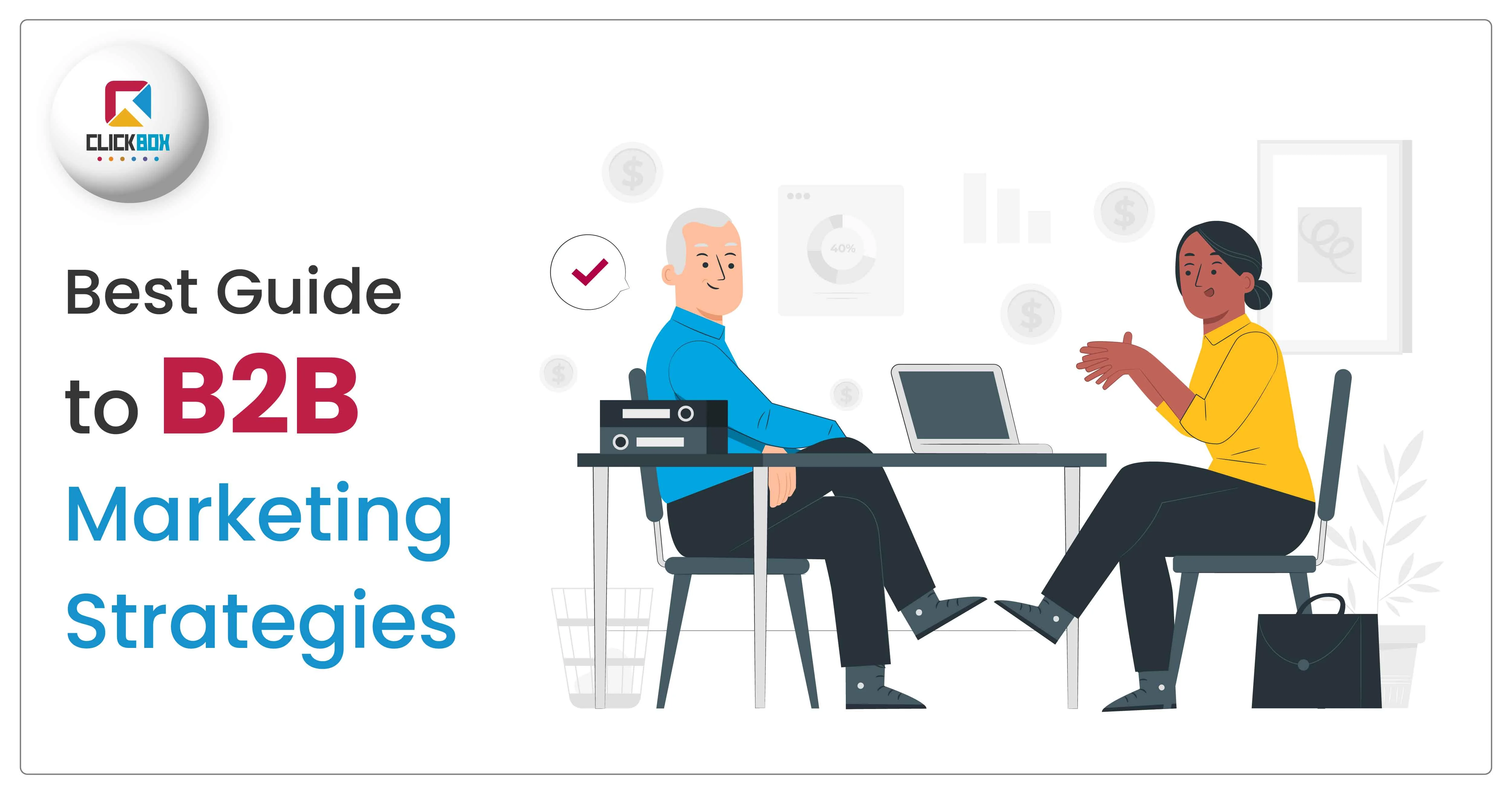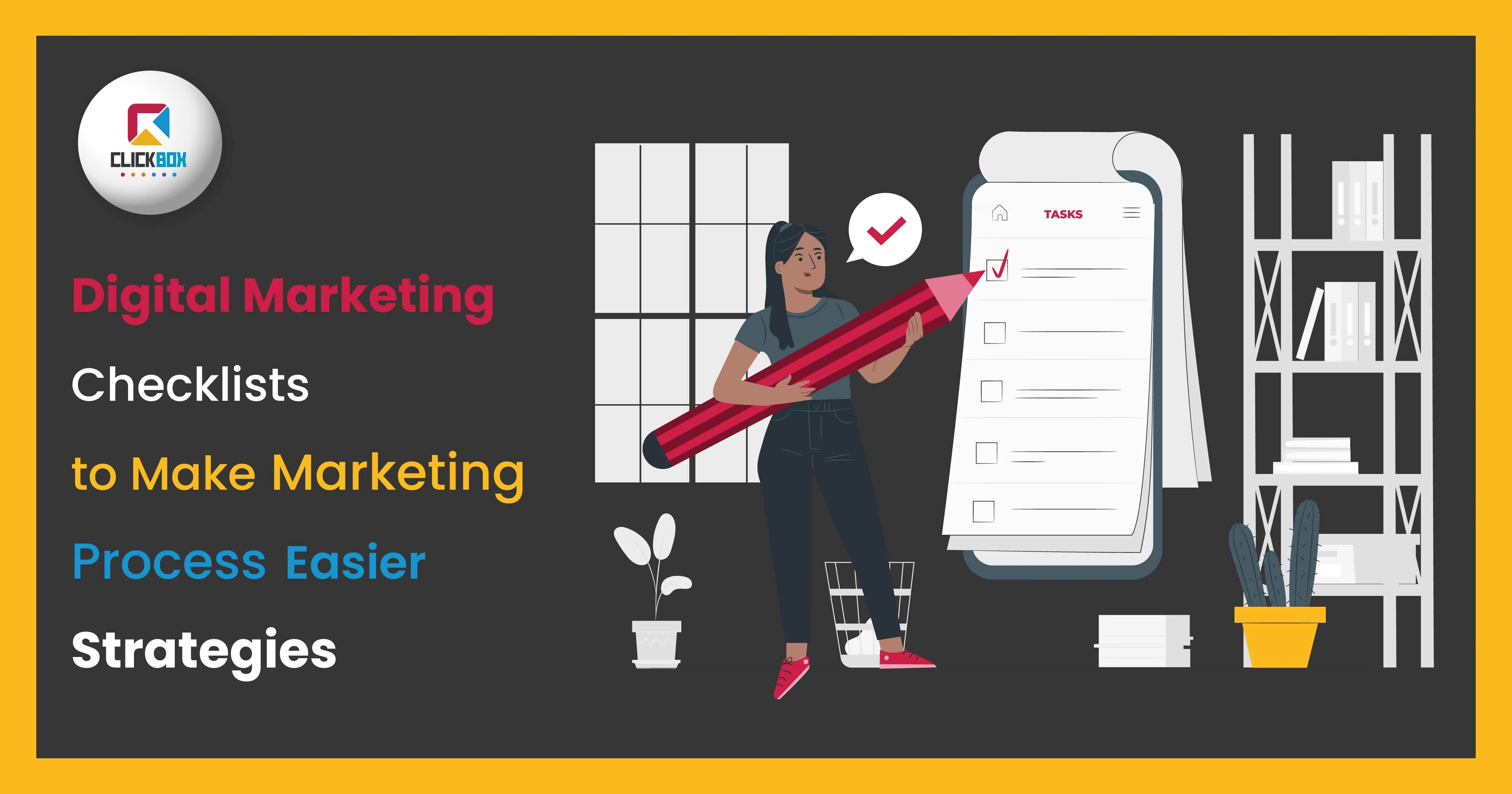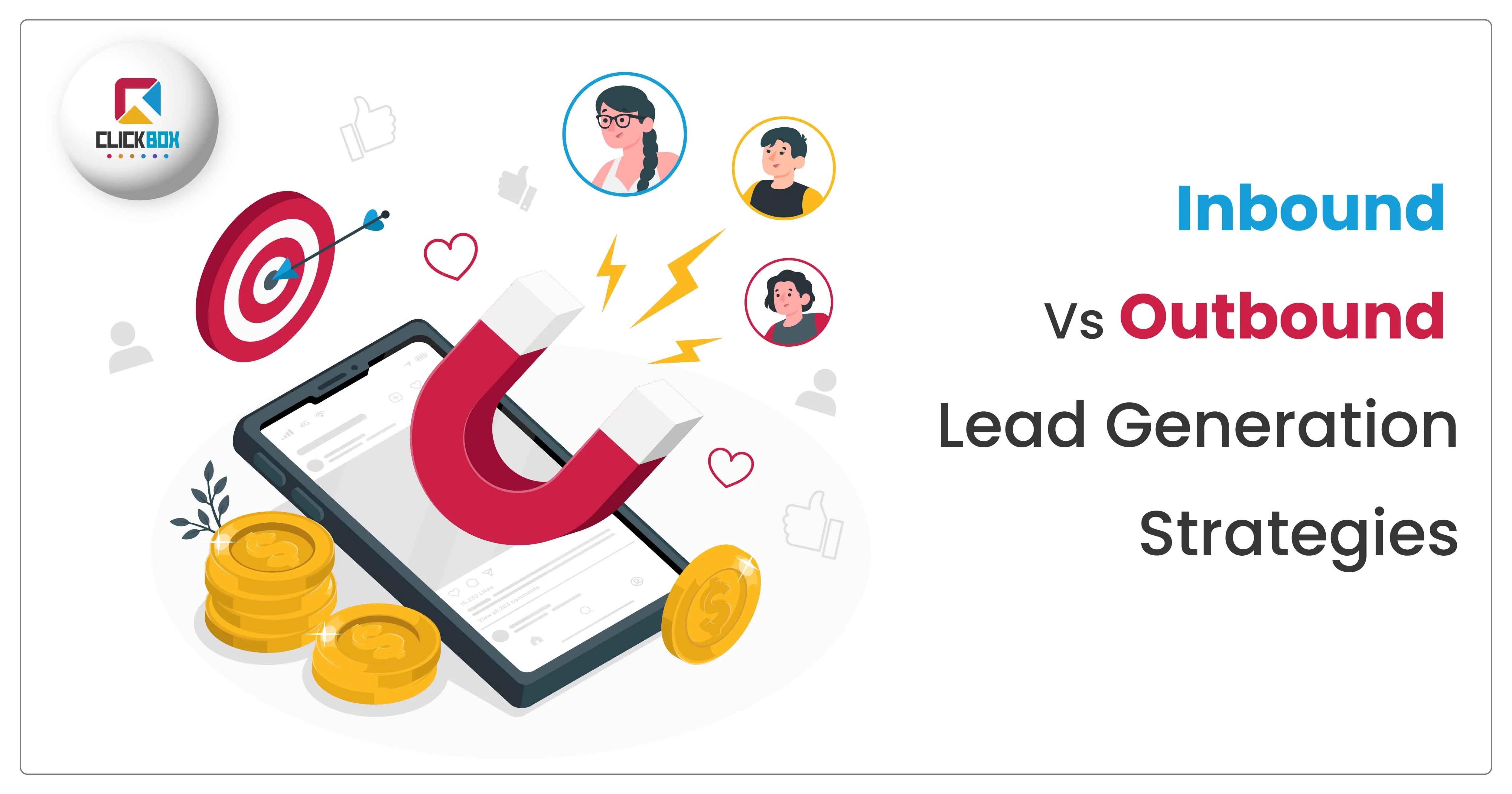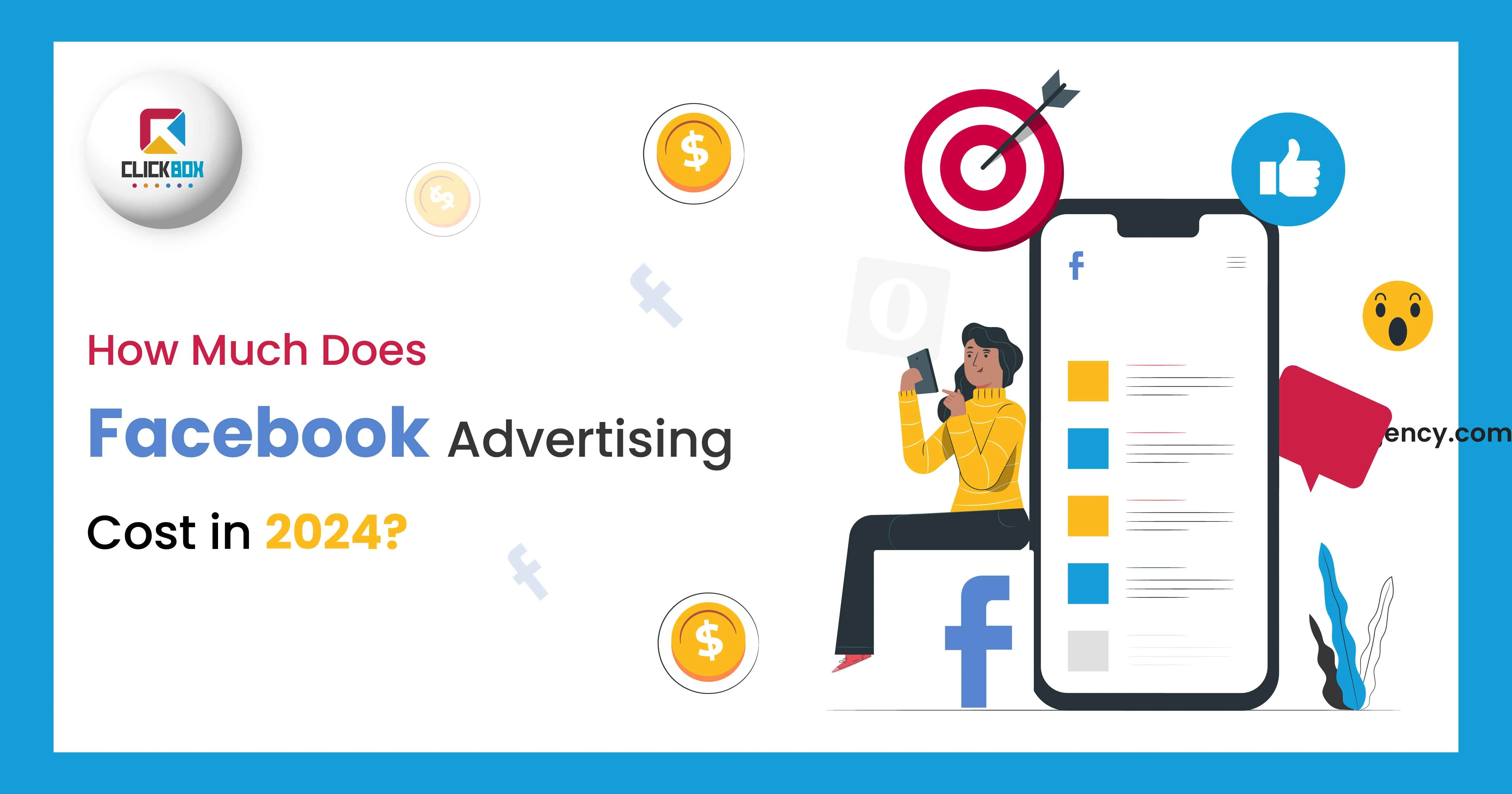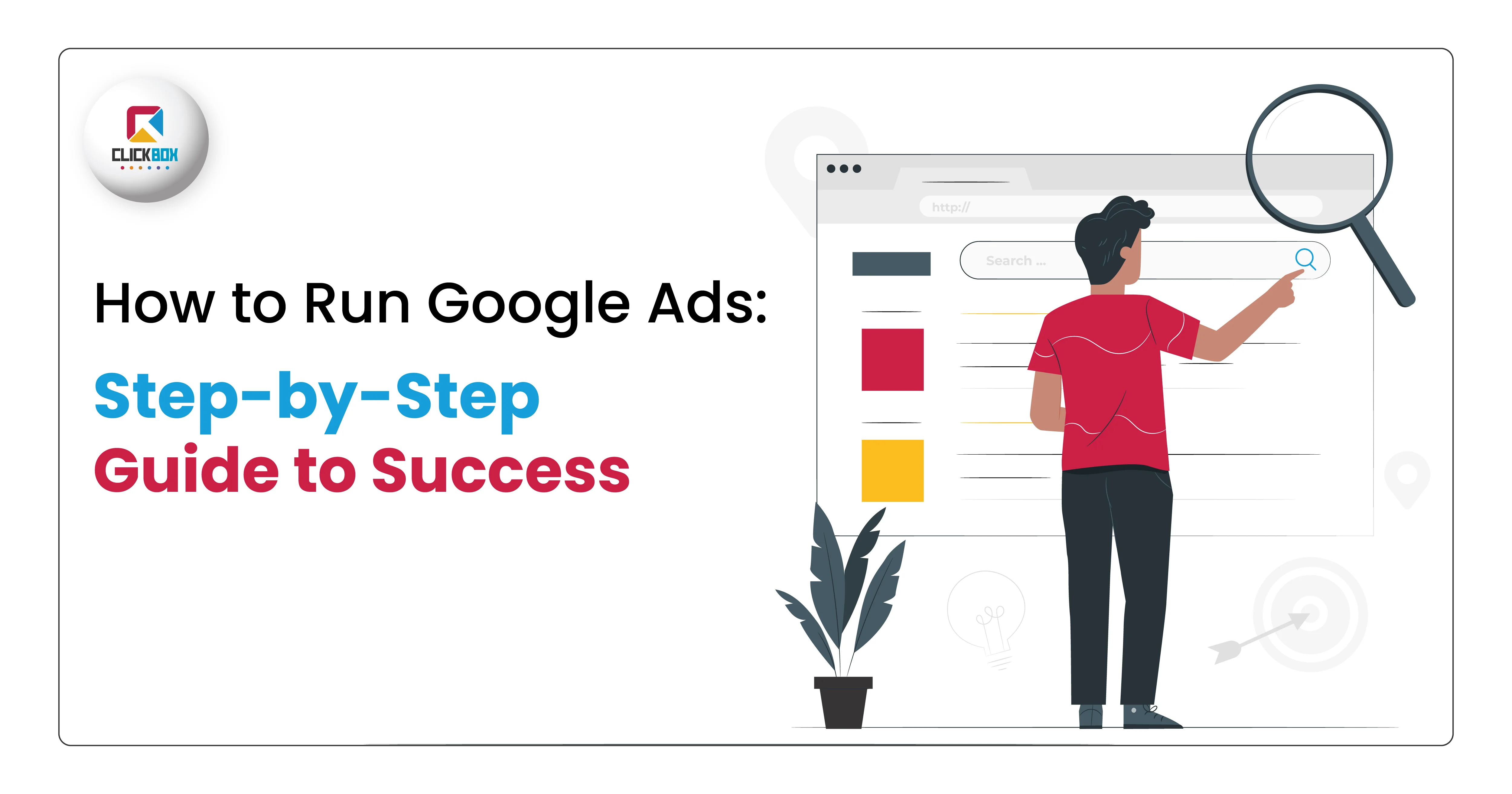
How to Run Google Ads: Step-by-Step Guide to Success
Welcome to the ultimate guide to running successful Google Ads campaigns! In the dynamic landscape of online advertising, mastering Google Ads is crucial for businesses aiming to boost visibility, attract target audiences, and drive conversions. Get ready to dive headfirst into the world of Google Ads campaign creation, optimization, and management with these detailed, step-by-step guidelines. With our professional advice and practical suggestions, you can turn visitors into buyers and take your online visibility to new heights. Indulge in the realm of Google Ads success with me!
A Quick Look at Google Ads
Any company owner serious about expanding their internet presence has to invest in paid marketing. Previously known as Google AdWords, Google Ads is a robust advertising platform that enables companies to create a wide variety of advertisements that may be presented throughout the Google advertising network. These ads can be responsive, display ads, shopping ads, call ads, video ads, mobile app ads, and more. Advertisers may narrow their target audience using Google Ads by utilizing keywords, demographics, interests, and more.
What does Google Ads do?
People use the Google search engine, search partners, the Google Display Network, viewers, websites, videos, YouTube feeds, mobile apps, and more to see ads. Advertisers can use Google Ads to get specific people to visit their website, which can help them get more leads and sales.
Step #1: Click on “Change to the advanced mode”
If you have never used Google Ads before, go to ads.google.com and click "get started." Google will walk you through setting up a Smart campaign as soon as you create your account. This looks good for advertisers who don't want to do the work, but it's worth it to take the time to make your own ads.
And don't pick "Main advertising goal" like Google tells you to. Instead, hit "Switch to expert mode."
Don't worry, though you don't need to be an expert to follow these steps! That's why I'm here.
Step #2: Pick your campaign type
What are you planning to cook?
Your Google Ads account is like a kitchen. Does it only hold scrambled eggs? We hope not! When you need more nutrition, you could make steak dinner. When you have a cold, you could make soup, when you want something spicy, and so on. So, just like there are different kinds of meals, Google Ads has different kinds of campaigns that are used for different things.
What kinds of Google Ads programs are there?
-
● Search Ads
-
● Display
-
● Video
-
● Shopping
-
● App
-
● Discovery
-
● Local
-
● Performance Max
Before you can choose a campaign, Google will ask you to pick a goal. Then, it will show you which marketing types are possible based on your goal. We're going to make a search ad for this guide, so let's pick website traffic.

Now we can see what’s available

Keep adding to your account over time, and don't stop at just one type of promotion. To reach your PPC goals, you should run a variety of ads. In the same way that a healthy kitchen makes different kinds of food, a healthy Google Ads account has different kinds of ads.
Get the kitchen ready
You can get your kitchen ready to cook once you know what you're going to make. In the case of Google Ads, this is where you'll choose the campaign's basic choices, such as
Name of the campaign: You can choose any name you want; it won't affect how well you do. You're good to go as long as your plan is simple to remember and organize in your account.
You can choose to have your ads show up on one of Google's partner networks. These sites can show your ad because they are Google companies. This can help you reach more people for less money, but it will be harder to get a high impact share.
Step #3: Set up the campaign
Preparing the kitchen for cooking is the next step after deciding what to prepare. Here is where you may choose the campaign's broad parameters, like in our Google Ads example.
Name of the campaign: Feel free to use anything you like; it will not affect your results. You should be able to recall and arrange your campaign easily within your account.
Network: You have the option to display your advertising on partner networks run by Google. These are Google wholly-owned subsidiaries that are authorized to display your ad. You can reach more people for less money, but getting a large percentage of impressions will be more challenging.

Step #4: Set your ad schedule
Choose a dinner date
Telling Google when to show your ads is like telling your friends when your dinner party is. That way, you only spend money when it really matters. For example, you might not want to show your ad very early in the morning, when people might not be ready to buy.
To make your plan, click "show more settings" and choose when to start and end your ads.

Watch out! If your account is set to a different time zone than the plan, you'll need to do some math if you want to advertise to people in different time zones. You can learn how to set up ad timing right here.
Step #5: Specify location & language
Make your party list.
You don't invite everyone you've ever met to your dinner party. You pick a few. This way, you can make the experience fit their hobbies and tastes. In the same way, you don't want everyone to see your Google Ads effort. This is where you choose your language and area.
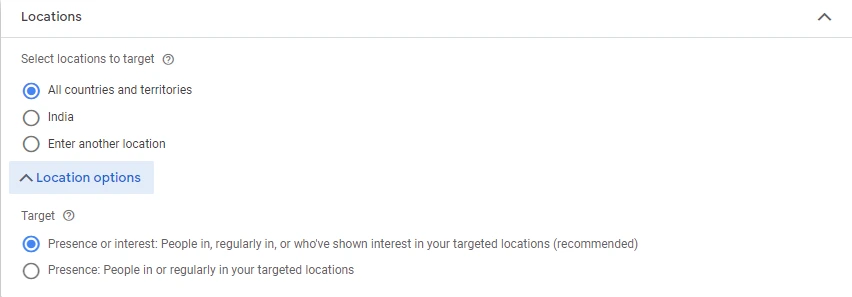
Mark "presence" so you don't show up for people who are "interested in" the place you choose but aren't there. Find out more about targeting based on location here.
The audience piece part will show up, but you don't have to go through it. In this box, you would put your remarketing groups. However, this isn't a popular way to use search ads.
Step #6: Calculate your daily budget
Get your seasoning juuuust right
It can be hard to season food when you're cooking. Too little, and you won't remember the meal. If you eat too much, it will make your taste buds sick. You should spend the same amount on Google Ads: if you don't, you'll always be learning. If you spend too much, you'll spend all of your monthly money in just one week.
To make the perfect budget, you must first get a rough idea of how much you spend each month. Do some keyword study first, and then look at Google Ads standards for your business to get an idea of what your average CPC or CPA will be.
Now, divide that number by 30.4, which is the average number of days in a month, to get your daily income.

Step #7: Choose your bid strategy
How do you cook?
If you want to reach different goals, Google can spend your money in various ways, just like there are various ways to cook a meal. You can choose your bid strategy by clicking "Or, select a bid strategy directly (not recommended)."
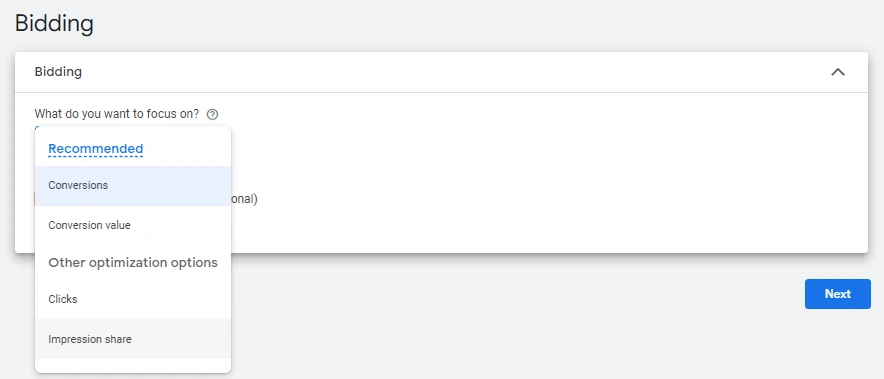
There are two types of tactics for bidding
Bidding by hand
You'll tell Google your highest CPC bid for each term if you're buying by hand. This is the most you're ready to pay for someone to click on that keyword's ad. You should know that this isn't always what you'll pay, it could be less, but it will never be more (read more about how the Google Ads sale works here). You have full control with this approach, but be careful setting your bid too low could hurt your chances of winning.
Bidding by computer
If you use automatic buying, Google will set your maximum CPC bids for a while. Just look at the numbers to get a sense of how much clicks will cost.
Step #8: Set up your keywords
Get your main items ready and start cooking!
One of the most important steps in running Google Ads comes next. Lack of supplies is like not being able to make a dish or run Google Ads.
Keywords are the words and sentences that people who want to find you on Google are putting in. With Google Ads, you bid on things that people will search for to see your ads. We'll talk about keywords soon, but for now, this is what your screen will look like:
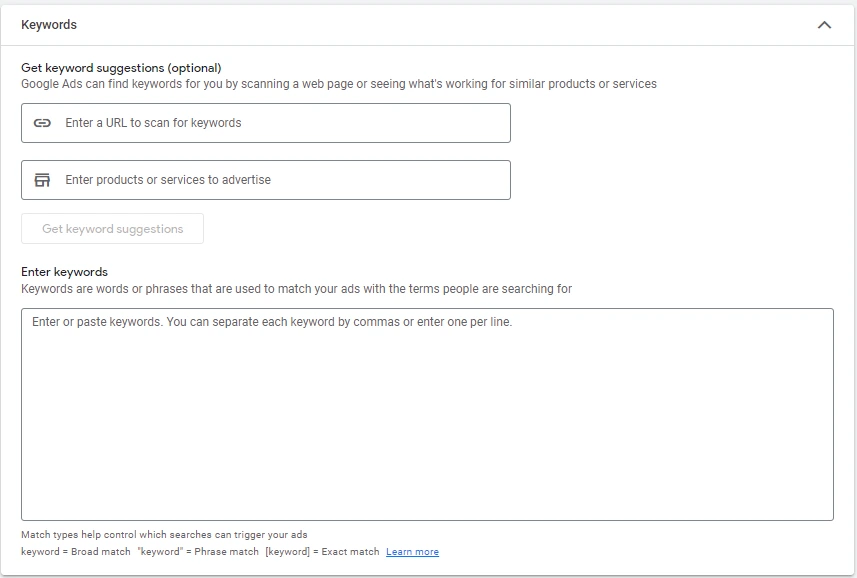
Name of the ad group. Ad groups are just containers for your ads and terms that help you keep track of your campaigns. For the best Google Ads account layout, you should put these into groups based on themes and give each group a name that fits.
Bid by default. If you're buying by hand, you'll need to set your maximum CPC bid for each keyword you add to an ad group. Our keyword study guide and the tips below will help you figure out what the likely CPCs are for the terms you've chosen.
PPC keyword pro tips:
Do focus on keywords that have a clear business purpose. Among these are "cost," "for sale," and other words. If you want to do local pay-per-click, you should focus on location-based terms like "PPC Campaign Advertising Company NJ"
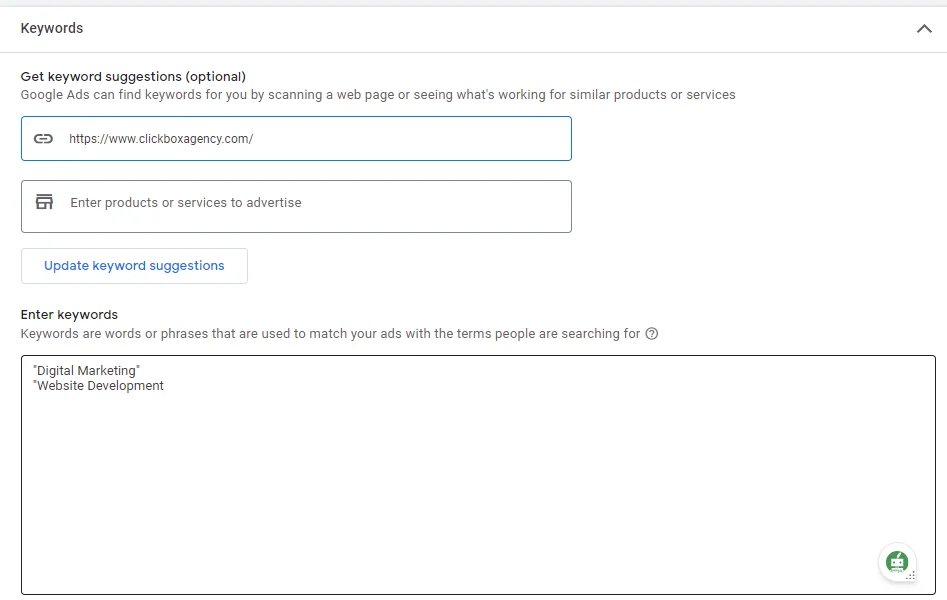
Don't just focus on keywords and ignore other ways to target. They are like the Kardashians of pay-per-click. They're very well known, but they don't make money by themselves.
When you set up your keywords, don't think about your bids (we'll get to this soon). You may not need to set a Max CPC bid for every keyword, but the goals of your bid strategy may change how you choose keywords and target them.
Don't fill up your keyword list with versions of your main terms that don't get a lot of searches. You can avoid a lot of trouble and keep your term count as low as possible if you use the right match types.
Match types
You'll need to choose the type of match you want when you type in your keywords. This is because people can do a lot of searches, or questions, that aren't exactly the same but are still very important to your keywords. Match types tell Google which of these different forms of your term you want your ads to show up for.
To be flexible, you should mix up the types of matches you make. From least restrictive to most restrictive, these are the three types of matches:
Broad match: This matches any search question that has something to do with your
Phrase match: This type of search finds questions that have the same meaning as your keyword.
Exact match: When you use exact match, your ad will only show up when a question has the same meaning as your query.
Step #9: Create your ad
Plating presentation
Okay, all of the food is ready and cooking. It's time to serve now. On the popular cooking show Hell's Kitchen, how the food is served is just as important as how it tastes. Also, no one will click on a stupid ad even if it has a great deal. No one will eat something that doesn't look good, even if it tastes good.
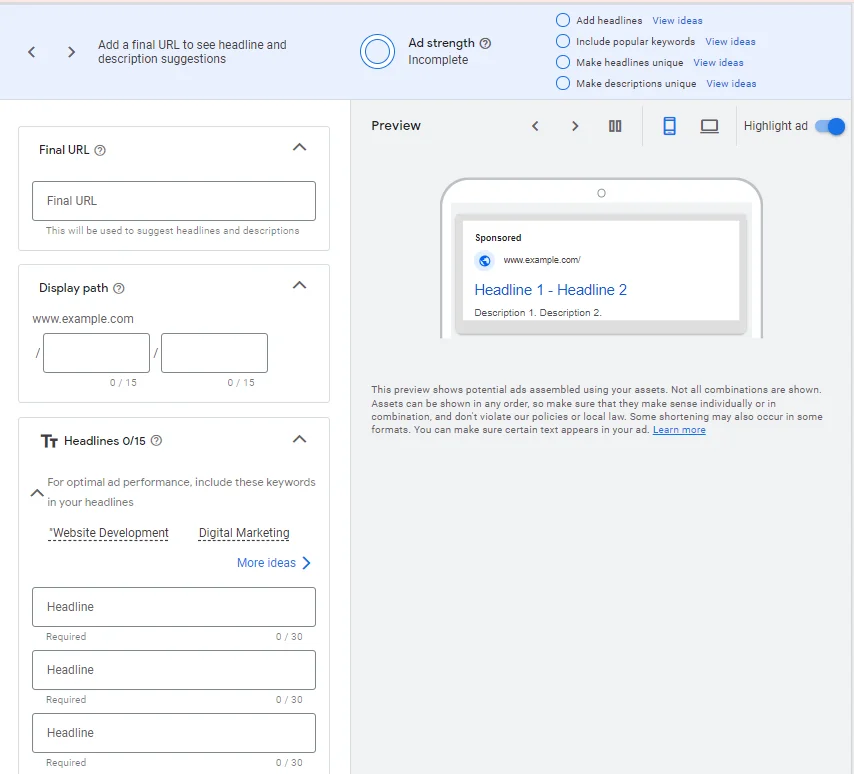
Google Ad copy pro tips
Remember to use flexible search and good habits. Because these ads are shown to people automatically, you need to make sure that every word or picture says something important.
Don't forget your call to action. After all, the point is to get people to do something. Make sure you always know what they want to do when they click. Add phrases like "sign up today," "call now," and more to help get more people to buy.
Do not be dull. Use feeling to market to make waves on the SERP, and look at our examples of ad writing for ideas.
Do not go too far. Your ads are like the "face" of your business. You want your brand to look nice, like a dish that's ready to be served. Don't give up this part of your work for a bunch of strong calls to action.
Step #10: Add on your ad extensions
Sides
While the main course is always the star of a well-prepared dinner, sides are always welcome. On occasion, they can even go well with the starter. That is precisely what ad extensions are. You may "strengthen" your ad with these extra lines of content to increase CTR and make it more noticeable.
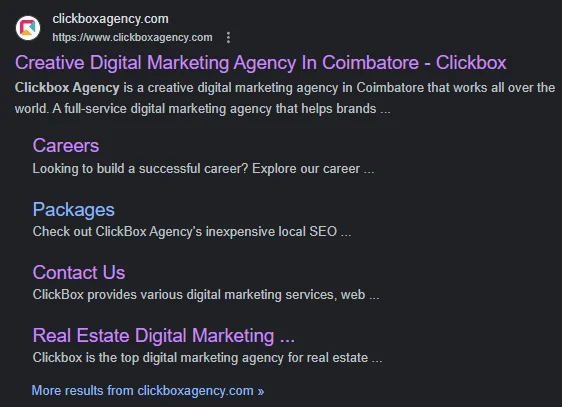
Even if they don't display or produce clicks, it won't be enough to cause your ad to fail. Ad extensions are available to make your ad stand out, so there's no reason not to give them a go.
In the left-hand column, you'll see the Extensions area. Here you may add extensions to your advertising. You will then be guided through the procedure by the Google Ads platform.
With ClickBox Digital marketing agency by your side, you can conquer Google Ads. Just remember that the secret to success is constant monitoring, adaptability, and inventiveness. In order to achieve long-term success in the dynamic world of internet advertising, it is crucial to stay active, evaluate results, and adjust strategy accordingly. May your Google Ads campaigns soar to new heights, attracting more qualified visitors and resulting in more sales.

Google is constantly updating and expanding the available ad extension options, which is the greatest part. To learn about all the available extensions for Google advertisements that you can use to improve your advertisements, have a look at our cheat sheet.
Step #11: Device targeting and extras
Add some sauce!
Shall we engage in some sensual engagement? Whether I'm practicing PPC or drizzling gravy on my potatoes, the golden rule remains: too much sauce is never enough. Feel free to experiment with all the advanced settings, such as device targeting.
By activating manual bidding on Search, you have the option to set a maximum CPC for clicks from certain devices. On the other hand, you can completely disregard them by lowering your bid by 100%.
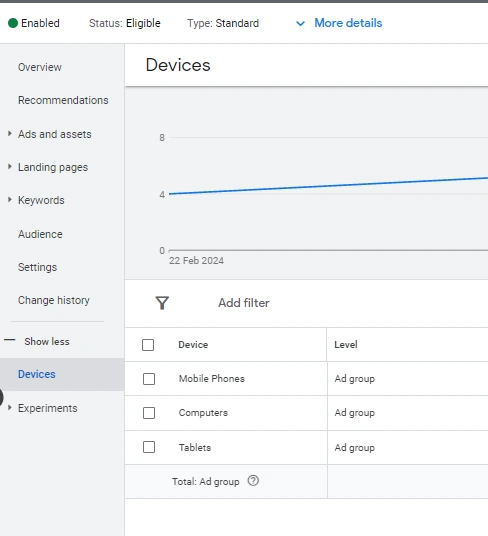
Enjoy yourself. Don't be scared to test a few various approaches until you find the one that works best for your target demographic. Also, don't immediately dismiss everything. If you initially exclude a device without evidence to support that it's underperforming, you may limit your findings.
Expert tip: This feature is also available under the Display campaign settings as a checkbox. If you want to see how your mobile or desktop approach is doing across all of your campaigns and bidding types, go no further than Google Ads' Devices area.
Step #12: Don’t forget your landing page
Dessert
Dessert is an essential part of every meal. Not up to scratch. Without a landing page, what good is a Google ad? Not succeeding.
As horrible as it sounds, one of the most challenging aspects of becoming a pay-per-click specialist is having to tell advertisers things they don't want to hear but really need to know. If your landing page isn't optimized, it won't matter how good your advertising is; they won't convert.
Your website is the one that gets the correct person to click, but getting them to click is only half the game. Last but not least, while building your Google Ads account, remember to focus on the destination of your viewers: a (hopefully) excellent landing page.
Some guidelines for creating effective landing pages are as follows:
Go over the specifics. Ensure responsiveness and security while optimizing for page performance.
Headline Only: Make sure the action you're taking (a button, a form, etc.) is visible and easy to use. Proclaiming your brand's many virtues may easily lead to wordiness. Make sure your guests may easily and swiftly accomplish their purpose for visiting your site.
Keep the design simple and appealing: For ideas, check out these landing page samples!
Step #13: Launch your ad
To serve!
The meal is ready! Before you save your campaign and make it public, double-check that your billing information is correct. Where do we go from here? Performance tracking is the remaining task.
You may halt or modify your campaign at any stage, so it's important to become acquainted with PPC reporting. Along those lines, it's a good idea to study up on important PPC indicators so you can identify potential improvement opportunities. Be wary of annoying ad disapprovals that can prevent your campaign from running.
Except for that, you may cruise away unharmed. A little breathing room and data collection will do wonders for your campaign. Patience is the enemy of pay-per-click advertising, I tell you what! Every two weeks to thirty days is a good rule of thumb for making modifications, and new campaigns can require an even longer interval. Now that you've constructed an incredible new Google Ads campaign, sit back and enjoy it.
John Click
Digital Marketer | SEO Copywriter | Content Strategist
Experienced digital marketer with a proven track record in creating compelling content that not only engages audiences but also drives conversions and enhances SEO visibility. My expertise extends beyond marketing strategy to crafting persuasive narratives that resonate with your target audience. I combine data-driven strategies with captivating writing to deliver measurable results, ensuring your brand shines in the digital landscape.



